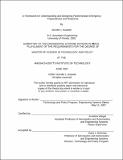A framework for understanding and designing partnerships in emergency preparedness and response
Author(s)
Gustetic, Jennifer L. (Jennifer Leigh)
DownloadFull printable version (746.3Kb)
Other Contributors
Massachusetts Institute of Technology. Technology and Policy Program.
Advisor
Annalisa Weigel.
Terms of use
Metadata
Show full item recordAbstract
Using partnerships between the public and private sectors to provide emergency preparedness and response (EPER) functions has become a useful and necessary tool for improving overall emergency management in the United States. Privatization has been studied comprehensively in many areas that are ripe for partnerships, but not in the field of emergency preparedness and response. Thus, this research fills that gap and advises both the architects of EPER partnerships and the policy makers that influence them, how to design partnerships based on the experience of former and existing EPER partnerships. In order to learn from existing partnerships, this research uses a case study method. After identifying and interviewing representatives from 16 EPER partnerships, this research classifies those partnerships based on several attributes. There are three general categories for those descriptive attributes: structural, functional and event. The structural attributes represent characteristics of a partnership that an architect has decision making power over. Functional and event attributes, on the other hand, are dependent on the EPER function being provided and are thus largely pre-defined for an architect. (cont.) This research identifies links between the independent variables -- the functional and event attributes -- and the dependent variables -- the structural attributes -- that will guide architects and policy makers in their decision making processes. In general, this research found that there are several event and functional attributes of successful past EPER partnerships that can inform the structural decisions of the architect. Also, this research finds that there are several lessons the policy maker can take from past EPER partnerships, including the importance of allowing and encouraging flexibility in the partnership design process.
Description
Thesis (S.M.)--Massachusetts Institute of Technology, Engineering Systems Division, Technology and Policy Program, 2007. This electronic version was submitted by the student author. The certified thesis is available in the Institute Archives and Special Collections. Includes bibliographical references.
Date issued
2007Department
Massachusetts Institute of Technology. Engineering Systems Division; Technology and Policy ProgramPublisher
Massachusetts Institute of Technology
Keywords
Technology and Policy Program.